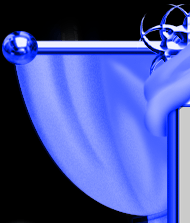|
UNIQUE SOLUTIONS, INC.
10001 NW 50th Street Suite 111 Sunrise, FL 33351
(954) 747-1919 OFFICE ~ Fax (954) 747-5399
****Soldering Jump Rings****Soldering Earring Posts on PMC****
Paste solder is much easier to use than the chips (pallions) and the flux. I am using an acetylene/air setup, but any torch setup will work just fine.
Soldering jump rings. This is a breeze with paste solder and also a great way to get used to the material. No big loss if you melt one. Close jump ring to match perfectly, then place a small (yes, very small) bit of paste solder at the join, making sure that there is a little solder touching both sides. The jump ring should be fully together and the paste should bridge over the line to connect both ends. Start hitting the jump ring with the flame pointing towards the area directly opposite the place to be joined and where the solder has been placed. GENTLY, make flame go around the ring as you continue to heat the ring, moving the flame all the time and not settling into one place. As the ring heats, the solder will flow. Make sure that the ring is attached at both ends and the solder did not jump to one side. If you have it to one side, then you can bring the solder to the other side (as long as the ends are touching) by slowly adding more heat on the side that does not have any solder on it yet. Remember, solder flows towards heat. When you are taking the first step of putting the flame on the ring, you are using the fact that heat expands an object and you ore counting on the fact that the heat on the opposite side of the seam will get heated and start to expand thereby making the seam tighter or making the ends move closer to each other. It is very important that the ends are tight before they are soldered. Practice with the jump rings and you will see how it works.
IF YOU DO HAVE A GAP... You can use the hard solder to fill the gap if it is not too big. After soldering the jump ring the first time and you have a place that is not connected, simply mound hard solder on that jump ring and then apply heat. to the PMC using number 56 or very soft paste solder. Make sure that the PMC has been burnished very well OR you can put in a small amount of sheet metal in the place that you are going to place the posts before firing and then you have a ready made surface to solder. The PMC is VERY, VERY porous. You need to close the holes (porosity) as much as possible by burnishing or eliminating the problem altogether by place in a small piece of sheet metal (fine or sterling covered all around with PMC). You will need to use a lot more paste solder (or any other solder) on the PMC as the holes let in a lot of solder. The fine silver does not tarnish as much as sterling, so think ahead as to what you want to do; PMC is fine silver. Either will take a great patina. A cross lock is a tweezers that holds onto an object when you close it, then when you push on it will release the object. Gently place the post into the solder and then draw out. You do not have to get any solder on the post; this is just how I do it. Then you gently heat the earring, pointing the flame all around and not concentrating it on the spot with the solder. The solder will get a hard crusty like appearance and it may smoke a very small bit. Keep the post positioned just above the solder, not touching, but close enough to get the heat from the flame of the torch. THEN.... The solder flows, QUICKLY place the post into the solder spot and draw up the heat along the post. This will make a good solder seam (join) and the post will not crack off. If you do not heat the post to the same temperature as the piece, then you stand a very good chance of having the post fall off. What has happened is that you have a cold connection and not a great solder join. Hold the post in the solder until it just flows on the post and then you can remove the flame. It is a learning curve just like anything else, and does take practice. Do try the jump rings first; if you overheat and melt, you have not lost much. Treat it as a learning experience. I usually use a charcoal block as a soldering surface. I like the compressed better than the regular as it lasts longer and has a flat surface and will not keep burning after you release the flame. All of my beginning students (I teach lots of fabrication classes) practice on jump rings first.
You do not clean out the syringe when you use the Unique Solutions paste. It is a non-drying formula. I do not even cap it. I have had a tube on my bench for over 2 1/2 years and check it every now and then to see if it has dried.... It has not. I recommend that you buy a small syringe (refillable) so that you have better control since it is small for your hands and easier to get the paste placed exactly where you want it.
Enjoy. Remember, there is no flux used with the paste solder, it is all self contained, and a NON-DRYING FORMULA
|




